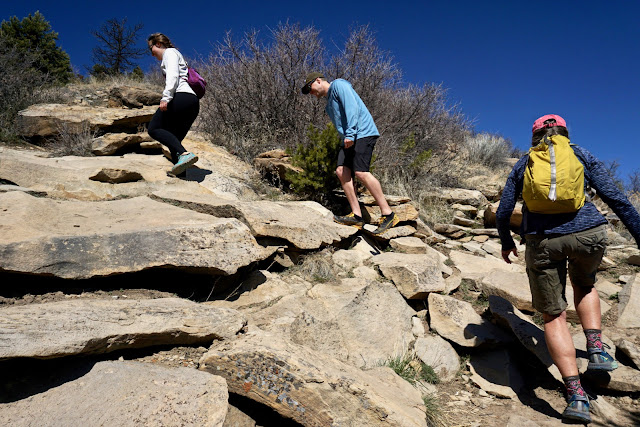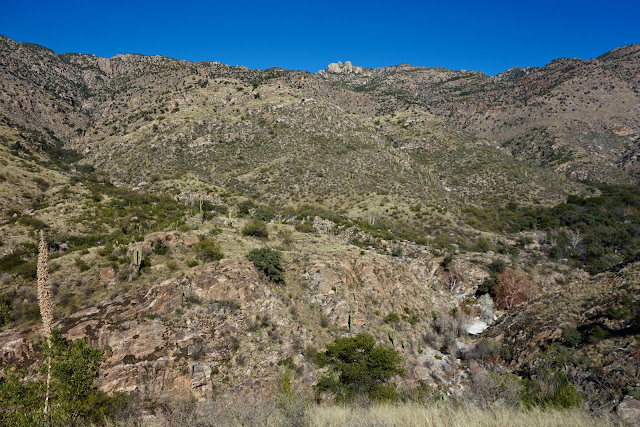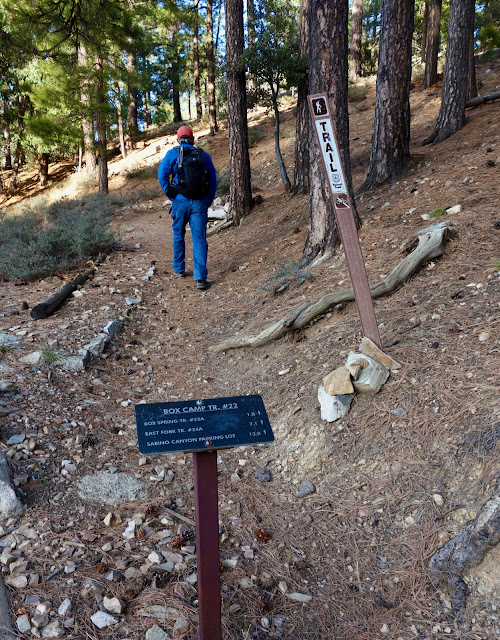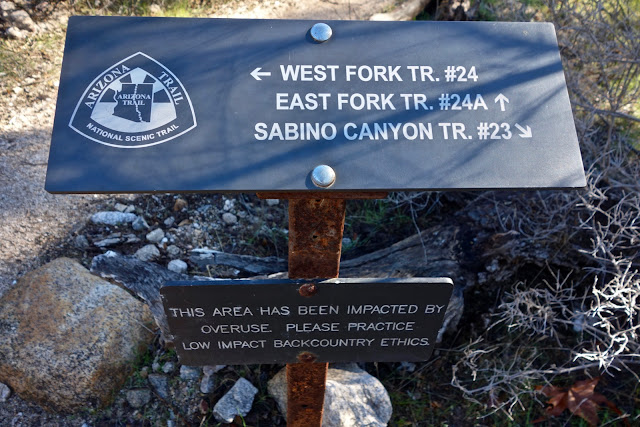Travel: Turn west off US 550 at South Camino del Rio. This is the first signal south of Santa Rita Park. As soon as the road starts to straighten, turn right onto CR 210. In less than 0.1 mile, turn right on Smelter Place. Trailhead parking is on the left in a dirt lot before the baseball diamonds.
Distance and Elevation Gain Roundtrip: East End Viewpoint is 2.0 miles with 1,050 feet of climbing. Smelter Mountain summit: add 2 miles and 450 feet of vertical. Dog Park: add 2.4 miles and 100 feet of gain.
Total Time: 1:00 to 2:00 from the trailhead to East End Viewpoint and back.
Difficulty: Unmaintained trail; navigation easy; no exposure assuming you stay a safe distance from the cliff.
Bodo State Wildlife Area, Winter Access Restrictions: Smelter Mountain is within the 2,923
acre Bodo SWA. From December 1 to April 15, the trail is open to the East End Viewpoint only. Hike between 10 AM and 2 PM. Dogs are not allowed and hikers are asked to stay on the trail. The restrictions are to protect wildlife habitat such as mule deer, year round residents. Please leave your dog at home or walk to the Dog Park in winter months. Leash your dog during open season.
Maps: Durango West, Colorado 7.5' USGS Quad; or, Trails Illustrated, Durango, Cortez, No. 144Reference: The Best Durango Hikes, Colorado Mountain Club, 2011. "Smelter Mountain," by John Bregar
Quote: You can observe a lot just by watching. Lawrence Peter Berra (Yogi Berra)
Multiple landforms constrain the Animas River Valley and City of Durango. Smelter Mountain creates a natural boundary on the southwest side of town. Mount the Sky Steps for the best visual of the mountain. The hiking trail goes up the ridgeline on the left.
Route: Ascend the southeast ridge to the East End Viewpoint, the black-line trail. To reach the summit walk west on a dirt road servicing communication towers, the blue-line. Extend your hike by walking south from the Dog Park to the trailhead, the red-line.
This post was written in the Spring of 2020 when the Coronavirus Pandemic ravaged the globe. Colorado governor Jared Polis issued stay-at-home orders. Schools were closed and all but essential businesses shuttered. Daily exercise was encouraged. Most Durangoans can get to the Smelter Mountain Trailhead by foot or bicycle.
Social-Distancing Guidelines During the Pandemic: The Smelter Mountain Trail is narrow. Keep at least six feet from other trail users. This is a family-centered field trip; hike with people in your household or go solo. When winter restrictions are lifted (April 16 through November 30), spread yourselves out by hiking early in the morning or late in the afternoon.
Outdoor Classroom: Students will learn about the history of Smelter Mountain, geology, flora, and geography. This hike is suitable for active children ages five and up. Take the ten-point quiz at the end of this post!
How Did Smelter Mountain Get Its Name?
The Durango Smelter began operating on a grand scale in1882. High heat stoked in kilns was used to extract silver, gold, copper, and lead from rock mined in the San Juan Mountains. The operation at what is now the Dog Park and baseball fields west of the Animas River was so significant the town was nicknamed Smelter City. The mill ran until 1930. With the advent of World War II, uranium was produced on the same site for two decades. Tailings are buried on the south side of the mountain at the 120-acre Bodo Canyon Disposal Site managed by the U.S. Department of Energy.
Trailhead Geology
There is a lot to learn right from the parking lot. Durango geologist John Bregar said Smelter, Raider Ridge and Crader Ridge are three in a series of hogbacks tilted up and rammed against the San Juan Mountains. Hogbacks are long, narrow ridges with steep slopes of nearly equal inclination on both flanks. Smelter is a continuation of Raider Ridge. The sandstone layers that hold up Raider Ridge come across the river and hold up Smelter.
There are four primary rock formations on Smelter Mountain. Once you know what you are looking for you will find the same rock layers on Perins Peak and Twin Buttes. Mancos Shale is the thickest and oldest formation. It underlies the Mesa Verde Group which is composed of three layers. Point Lookout Sandstone is the lowest (and therefore oldest) member of the Mesa Verde Group, deposited in the Cretaceous era as the Western Interior Seaway receded. It is named for the dramatic protruding cliff at the entrance to Mesa Verde National Park.
The middle layer is the Menefee Formation. It contains coal veins so pure the D&SNG shovels it into their fireboxes. Capping the ridge is Cliff House Sandstone, the youngest member of the Mesa Verde Group. The formation was named for the Ancestral Puebloan habitation sites built in alcoves typically found in this layer. It was deposited when the sea was rising to inundate the Colorado Plateau once again. Just think, the rise and fall of the sea is recorded in the rocks.
Smelter Mountain Trailhead, Elevation 6,540 Feet
Let's get hiking! From the trailhead notice the three bands of Point Lookout Sandstone on the front face of the mountain. This is the southeast ridge and we'll be walking up it all the way to the top.
The single track descends about 50 feet to an ephemeral creek that collects water from the south flank of the hogback. Jump across the pretty little stream flowing over a sandstone bed.
The trail climbs to a powerline support tower and there it splits. Turn left to climb the mountain. Straight ahead is a popular backdoor entrance to the Dog Park. We'll talk about that trail later. Winter access restrictions are posted as you pass into Bodo State Wildlife Area. If you brought your dog during the restricted months, go play in the Dog Park.
The trail braids multiple times on the lower mountain. I like to go right at the Bodo SWA boundary sign. The trail contacts beige-gray Point Lookout Sandstone. The fun begins in the big slabs and blocks. (Thomas Holt Ward, photo)
Beside the path is an example of Liesegang rings made from minerals in sedimentary rock. The mustard-colored banding goes all around the surface of the rectangular rock. Now that you are alert to this distinctive banding you will see it throughout the Point Lookout formation.
The trail splits again under the third cliff band. The left hand option is a little more tame with natural stone steps.
(THW, photo)
Turn right if you like to play around on big rocks. Practice your scrambling techniques! Put yourself into four wheel drive by using your hands for extra propulsion. (THW, photo)
The two trails come back together on a sandstone table. The banana yucca was a food source for Native Americans. In late spring a long cluster of large, white flowers with a purple tinge will shoot up from the broad, spine-tipped leaves. Return in the fall when the fruit is ripe and sweet. (THW, photo)
John Bregar explained that long ago the outwash plain for the Animas River used to be at this level, 6,900 feet. During the Quaternary glacial period, boulders and cobbles were deposited when ice dams shattered at the terminus of the glacier. All that remains on Smelter Mountain is this little pocket. The boulders have various markings and colors. The rocks are named for places we all know and love: Eolus Granite, Uncompahgre Quartzite, and Snowdon Quartzite.
The gravel quarry on Highway 3 is mining an alluvial deposit from the same geologic era.
Enter a piñon and juniper woodland with a few ponderosa pines scattered about. There are two types of juniper. The Rocky Mountain juniper typically has a blue-green cast, image-right. It is sometimes called a "weeping" juniper because its leaves are feathery and droopy. The Rocky Mountain juniper grows straight up from a central trunk and is peaked or rounded at the top. It can grow to be 30 feet tall.
Smelter is a wintertime fitness favorite because it is free of snow earlier than other grades in town. Give it a few days to dry out or you will be mired in thick, gushy, slippery, mud. During mud season I am especially fond of these stepping stone slabs.
You will know when you contact the Menefee Formation because the trail platform turns black. The D&SNG obtains their coal from a Menefee seam mined by the King Coal II Mine in Hay Gulch.
Arrive at an exhilarating and open air lookout at 0.8 mile, 7,280 feet. What an exciting view of town and points north. This little opening is so satisfying some hikers call it good enough and turn around here. The next lift looks a little daunting but by now you've got most of the elevation gain put away. Dig deep and heft up the last 300 feet to the top. (THW, photo)
Transition to the Cliff House Sandstone formation. It is the topmost resistant bed in the Mesa Verde Group. It is so strong and powerful it holds up the Smelter ridge crest. It is easy to distinguish from other formations by its yellow hue. In the image below, Cliff House boulders are slumping down on the Menefee. This is a good example of a geological contact line.
The rough trail climbs steeply west along the north rim of the ridge with frequent views through Gambel oak.
(THW, photo)
(THW, photo)
Be sure to swing around and look south to Bodo and Carbon Mountain. (THW, photo)
A row of yellow Cliff House blocks jutting out over thin air signals arrival at the East End Viewpoint. Golden eagles and red-trailed hawks circle overhead and the vista is downright astonishing. In your euphoria, don't just plop down on any old rock. Choose your boulder carefully--erosion is a powerful and capricious master. Young children need attentive supervision.
This is every local's favorite view of town. Name what you see: the Animas River pulsing blue power, the crescent-shaped Train Depot, historic downtown, US 550 and US 160 joining at Camino del Rio, Main Avenue heading north arrow straight, and Fort Lewis College up on the Rim. On the second level are Animas City Mountain, Missionary Ridge, Raider Ridge, and Crader Ridge. In the north and east, so high they are touching the sky, are the San Juan Mountains: Engineer Mountain (off-image), the Twilights (West Needle Mountains), and Mountain View Crest. (THW, photo)
Northwest are the La Plata Mountains. In the midway zone, Point Lookout Sandstone cliffs ring Twin Butte East and compose the east scarp of Perins Peak. The Hogback is a classic example of Mancos Shale.
The summit ridge is closed to hikers west of the East End Viewpoint from December 1 through April 15. The crest of the hogback is one mile west. It is the fifth and final roller and each one is planted with communication towers of various sorts and small buildings.
Walk west on the dirt service road. Spurs peel off to the towers. Check them out or flank the ridgecrest on the south with a view of Lake Nighthorse. (THW, photo)
The summit is topped with appliances but it does render an unusual perspective on the Animas River Valley. Runners can create a six-mile loop by going south on CR 212 and east on paved CR 210 back to the trailhead.
Durango Dog Park Access:
I like to tie up my townie at the north end of the Dog Park and walk 1.2 miles south to the Smelter Mountain Trail. Not only is it a great warmup, the Dog Park is always a cheerful place. Many tracks cross the north platform. You can walk near the river or tuck beneath the east face of the mountain.
The bench narrows to the width of an abandoned road high above the river overlooking Whitewater Park.
People and dogs pass this way often but there is a risk. Big blocks break with alarming frequency from the Point Lookout Sandstone cliffs and litter the narrow passage. I have been walking here for twenty years and there's a new fallen boulder every time I pass by. This is not a place to hang out.
Smelter Mountain Outdoor Classroom Quiz
1. How did Smelter Mountain get its name?
2. What do geologists call a long, narrow ridge with equally steep slopes on both flanks? Extra credit: Smelter Mountain is a continuation of what ridge on the east side of the Animas River?
3. What are the three rock formations in the Mesa Verde Group?
4. Order them oldest to youngest.
5. Name the color of each formation.
6. How did the colorful rounded cobbles and boulders in the alluvial pocket get way up on the hill?
7. Two kinds of junipers live on Smelter Mountain. What are they and how do you tell them apart?
8. What plant bears tasty fruit in the fall?
9. What is the mountain range northwest of Durango?
10. What is the mountain range north and east of Durango?



































































